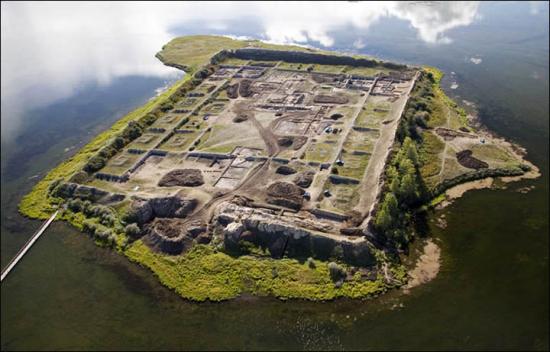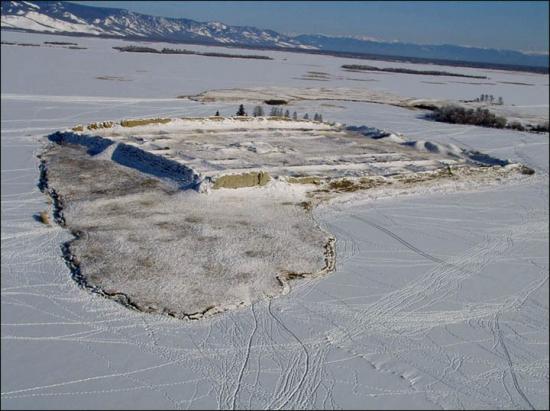Derek Lambie
Source - http://siberiantimes.com/science/casestudy/features/f0009-who-built-this-siberian-summer-palace-and-why/
Experts still divided over mysterious 1,300-year-old fortress-like structure located on island in middle of lake.

1,300-year-old structure could be a fortress, summer palace, monastery, or even an astronomical observatory. Picture: gdehorosho.ru
With its island location and towering square walls that were once impenetrable, it looks at first glance to be an ancient fortress or kremlin to keep out enemies. Others believe the 1,300-year-old structure in rural Siberia has more mystical properties and might have been a summer palace, monastery, or even an astronomical observatory.
Whatever it is, more than a century after it was first explored, archaeologists are no further forward in discovering the secrets of Por-Bajin, who built it or why.
Most likely constructed in 757 AD, the complex has fascinated and frustrated experts in equal measure since it was located in the middle Tere-Khol, a high-altitude lake in Tuva, in the late 19th century.
First explored in 1891, with small-scale excavation work later carried out between 1957 and 1963, it was not until 2007 that proper research took place at the site.
Archaeologists found clay tablets of human feet, faded coloured drawings on the plaster of the walls, giant gates and fragments of burnt wood. But nothing yet has provided a definitive answer as to why the structure was built, and excavation work continues.

Por-Bajin on the map of Uighur Kaganate. Picture: Irina Arzhantseva
'Por-Bajin is legally treated as one of the most mysterious archaeological monuments of Russia,' says the official website for the complex, about 3,800km from Moscow.
'Apparently it was built at the period of the Uighur Khagante nomadic empire (744-840 AD), but it’s not clear what they built a fortress for in such a solitary place, far from big settlements and trade routes. 'The architecture also produces many questions and it has reminders of a model of an ideal Chinese city-palace.'
Por-Bajin, which translates as 'clay house' in the Tuvan language, is located in the very centre of Eurasia, on the borders of Russia and Mongolia. It sits on a small island in a lake high in the mountains between the Sayan and Altai ranges, about five miles west of the isolated Kungurtuk settlement in southern Siberia.
Laser mapping of the site prior to the first major excavation in 2007 helped experts build a 3D model of what the community might have looked like. Despite its age, parts of the structure were well preserved when archaeologists arrived to examine the 3.5 hectare site, with walls clearly visible.
Outer walls standing 10 metres tall and 12 metres wide formed a rectangular shape, creating what many have interpreted as a protective kremlin-like fortress. A main gate was discovered, opening into two successive courtyards connected by another gate.
Walls on the inside were smaller, at about one metre-tall, forming the outline of buildings, with a large building in the centre of the site. Some of the walls and panels were covered with lime plaster painted with horizontal red striped.
The main complex in the inner courtyard had a two-part central structure, one behind the other linked by a covered walkway. It had a tiled roof and was supported by 36 wooden columns resting on stone bases.



Construction materials, and the way the site is laid out, told the experts it was built in a typically Chinese architectural tradition, most likely in the second half of the eight century. Pictures: gdehorosho.ru, Irina Arzhantseva
Construction materials, and the way the site is laid out, told the experts it was built in a typically Chinese architectural tradition, most likely in the second half of the eight century.
'The building was most likely of the post-and-beam construction characteristic of Chinese architecture from the T’ang Dynasty,' wrote head archaeologist Irina Arzhantseva in a report published in The European Archaeologist in 2011.
'Finds of burnt timber fragments point to the use of the typical Chinese technique of interlocking wooden brackets, called dou-gung. Ramps led down to the two flanking galleries which were roofed, open spaces looking onto the access to the main pavilion.'
PART.2